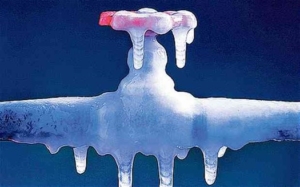Pipe Freeze, Part 1 of 3
What Causes Pipes to Burst?
Burst pipes are a major source of angst for property managers and insurers, particularly when temperatures plunge well below freezing for a period of time, freezing our pipes, roads and sidewalks. Substantial property damage is often incurred when a sudden drop in temperature causes pipes to freeze and burst.
It is a common misconception that pipes burst because the water inside the pipe freezes and then expands. What really causes burst pipes and how can this be avoided?
Water begins to freeze below 0 degrees Celsius (32 Fahrenheit). When water freezes inside a pipe, it creates an ice dam. Some materials such as Pex piping are designed to withstand expansion caused by a blockage or dam better than previous metal and plastic piping but still have their limits. As the ice expands inside a pipe it greatly increases the pressure of the trapped water and eventually the pipe bursts at its weakest point, releasing the pressure which can often involve hundreds, if not thousands of gallons of water.
The weakest point may be exceptionally weak (where it should have been able to withstand the pressure) or it may be commonly weak (due to joints or connections which are naturally weaker than the pipes themselves).
How long does it take for water in a pipe to freeze?
There is not a definitive time period for pipes to freeze. There are various factors that determine the amount of time. Some important factors include ambient temperature, insulation and pipe location. As a general rule, air temperature must remain at 20° for approximately 6 hours in order for pipe freeze to become a risk. We must keep in mind, however, that pipes with little or no insulation could freeze in as little as 3 hours.
A simple way to estimate length of time is as follows:
- Well-insulated pipes – Up to 6 hours until freeze
- Poorly insulated or uninsulated pipes – As little as 3 hours until freeze
- Average pipe insulation – Around 4 to 5 hours
In our next post we will cover 3 contributing factors that often lead to weak points in piping: improper installation, corrosion, or manufacturer’s defect.



